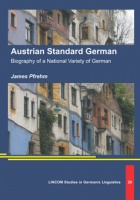 LINCOM Academic Publishers has recently published Prof. James Pfrehm’s (Dept. of Modern Languages & Literatures) book Austrian Standard German: Biography of a National Variety of German (http://lincom-shop.eu/shop/article_11347%2520ISBN%25209783862885886/LSGL-29%3A-Austrian-Standard-German.html?shop_param=cid%3D253%26aid%3D11347%2520ISBN%25209783862885886%26)
LINCOM Academic Publishers has recently published Prof. James Pfrehm’s (Dept. of Modern Languages & Literatures) book Austrian Standard German: Biography of a National Variety of German (http://lincom-shop.eu/shop/article_11347%2520ISBN%25209783862885886/LSGL-29%3A-Austrian-Standard-German.html?shop_param=cid%3D253%26aid%3D11347%2520ISBN%25209783862885886%26)
In today’s academic circles, the idea has become widely accepted that each nation within the greater German-speaking geographic area presides over its own standard variety of the German Language: German Standard German (GSG) in Germany; Swiss Standard German (SSG) in Switzerland; Luxembourgian Standard German (LSG) in Luxembourg; and Austrian Standard German (ASG) in Austria, to name the most salient national varieties. Indeed, this linguistic reality lies at the heart of the pluricentricity argument. For ASG in particular, the path to national variety recognition was centuries in the making, having come to fruition within the last few decades.
In this Biography of a National Variety of German, Pfrehm address key questions pertaining to the historical emergence of the Austrian national variety. Among others, he considers: At what point in the history of the German language was the notion of an Austrian national variety of German conceived of; specifically, when were its forms and functions shaped, accepted as a sociolinguistic reality, and implemented? Which individuals contributed to the shaping, acceptance, and/or implementation of ASG? And finally, which historical contexts played a role?
The exploration unfolds in six chapters. Chapter one, “Describing Austrian Standard German,” is a brief overview of the most salient structural linguistic forms of ASG: its vocabulary, phonology, morphology, and syntax. Chapter two, “From the Great Migration to the Doorstep of Enlightenment and the Modern Era,” considers the earlier history of the German language, as an assemblage of regional dialects in the pre-Modern era, up through the emergence of an inchoate standard variety within the Holy Roman Empire under the Habsburgs. Chapter three, “Enlightenment and Language Standardization,” focuses on the eighteenth century as it examines the first systematic efforts to supra-regionally normalize the German language. The discussion in chapter four centers on key 19th-century sociopolitical and sociolinguistic developments within the greater German-speaking areas of Europe. Chapter five moves into the 20th-century and addresses a number of sociopolitical circumstances and individuals that played a role in pan-Germanic and Austrian nationalistic sentiments, and which were crucial for the ideological and structural elaboration of ASG. Finally, the biography of the Austrian national variety ends with a look at the contemporary status quo of the national standard, with a particular eye to Austria’s role in the socioeconomic integration of Europe, via the European Union.